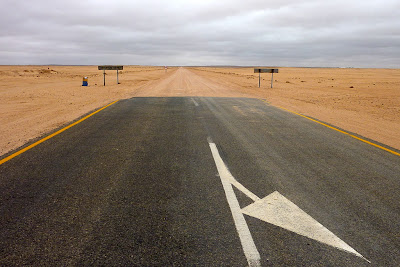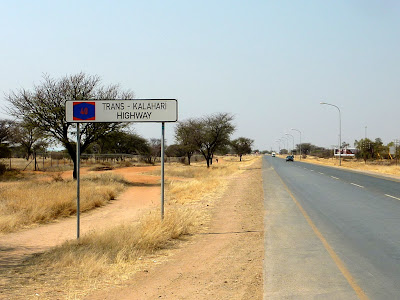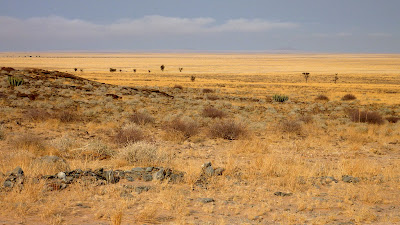28 August 2010
The crossing of Namibia-Botswana border went swiftly and smoothly. I didn't need the visa for Botswana, didn't have to pay anything and even the question what should I state as a "registration number of the vehicle" on the immigration form was resolved relatively quickly. As a pleasant greeting into Botswana, there was an excellent tarred road with 1,5 m wide shoulder, separated from the traffic lane with a solid yellow line. And to make my entry even more agreeable, there was a 100-rand note lying in the grass just outside of the Botswana border building.
Trans-Kalahari has "bicycle lanes" in Botswana
The stretch of the Trans-Kalahari highway that lay before me was the most deserted of the whole trip: there were 80 km untill the last village with a source of water and then another 310 km until the town of Kang, without any facilities in between. I was a bit worried if my 3 liter capacity will be enough, but with a bit of discipline, i.e. drinking just a gulp of water every half hour, I made it safely to Kang in two days. I was amazed with my fast progress, so that I planed to make the final 420 km stretch from Kang to Gaborone in a randonee style, within 24 hours, riding through the whole day and night. Well, that didn't realize, I got fed up with night riding after only 2 hours.
The village kiosk
Contrary to Namibia, there were no fences along the road. According to what my hosts in Witvlei told me, that should mean that animal encounters would be more common and even seeing a lion would be possible. Fortunately, or unfortunately, that was not the case. I saw practically no wild animals in Botswana and even the donkeys and horses, that grazed by the road, run away as soon as I approached.
Botswana real estate
Playing the sticks game
My main task in Gaborone - apart from stuffing myself with bags of food - was to recharge the battery of my camera. The electricity plug-ins in Botswana (and in South Africa) have a strange three-part form and it took a considerable amount of well aimed force to use it with the type of adapter that I have.
Botswana's vista
Day 10: 159 km. Day 11: 230 km. Day 12: 188 km. Day 13: 148 km. Day 14: 97 km. Total: 1958 km.
 I've choosen a particulary interesting itinerary, covering Namibia, Botswana, South Africa and Lesotho. This mini "coast-to-coast" tour in Africa has all the potentials to become one of my favorites.
I've choosen a particulary interesting itinerary, covering Namibia, Botswana, South Africa and Lesotho. This mini "coast-to-coast" tour in Africa has all the potentials to become one of my favorites.





























